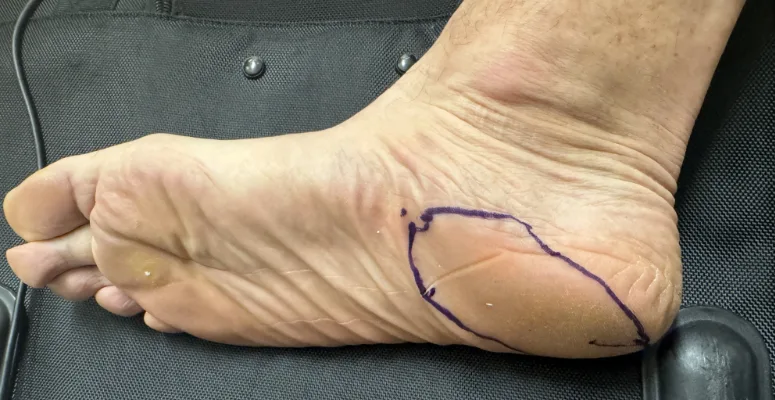What is it and how is it treated?
When your first few steps out of bed in the morning cause severe pain in the heel of your foot, you may have plantar fasciitis (fashee-EYE-tiss). It’s an overuse injury affecting the sole or flexor surface (plantar) of the foot. A diagnosis of plantar fasciitis means you have inflamed the tough, fibrous band of tissue (fascia) connecting your heel bone to the base of your toes. Podiatrists typically name this diagnosis “heel spur”, but orthopedic foot and ankle specialists more commonly use the diagnosis of plantar fasciitis, as the plantar fasciitis is the cause of the heel spur (a traction spur).
Office Appointments and Telemedicine with Dr. Carreira

You can also book an office appointment or a telemedicine visit by calling Dr. Carreira’s office at 404-355-0743. Book now.

The line drawn on the foot highlights the typical location of pain in plantar fasciitis, centered around the heel.
You’re more likely to get the condition if you’re a woman, if you’re overweight, or if you have a job that requires a lot of walking or standing on hard surfaces. You’re also at risk if you walk or run for exercise, especially if you have tight calf muscles that limit how far you can flex your ankles. People with very flat feet or very high arches are also more prone to plantar fasciitis.
The condition starts gradually with mild pain at the heel bone often referred to as a stone bruise. You’re more likely to feel it after (not during) exercise. The pain classically occurs again after arising from a midday lunch break.
If you don’t treat plantar fasciitis, it may become a chronic condition. You may not be able to keep up your level of activity and you may also develop symptoms of foot, knee, hip and back problems because of the way this disorder changes the way you walk.
Treatment Recommendations for Plantar Fasciitis
Treatment Recommendations:
- Activity modification: Once the pain has resolved, return to long walks, etc. gradually.
- Orthotic inserts such as a longitudinal arch support with a heel cushion or a silicone heel cushion alone.
- Avoid walking barefoot and wear supportive, shock absorbing shoes.
- Stretching
- Supervised physical therapy with focus on appropriate form for stretching.
- NSAIDS: for example, naproxen (Alleve), ibuprofen (Motrin, Advil).
- Night splint: keeps the plantar fascia on stretch.
- Cortisone injections: rarely used, limited number of injections and only in chronic cases.
- Surgical release: when all else fails.
Download Treatment of Plantar Fasciitis » (PDF: 290KB)


